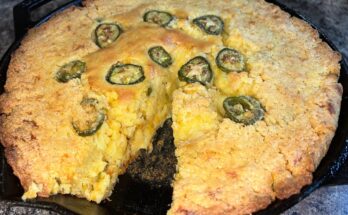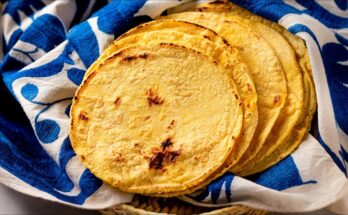Cookie Butter Recipe: Let’s be real: cookie butter is dangerously delicious. You’ve probably seen it at Trader Joe’s or maybe you’ve dipped a spoon into a jar of Biscoff spread and thought, “How is this legal?” Well, here’s some great news: you can make it at home, and it’s surprisingly easy!
In this guide, you’re going to learn how to whip up the most creamy, rich, and mouthwatering homemade cookie butter. It’s the kind of recipe that turns your average afternoon into something special. Even better? It’s customizable, budget-friendly, and preservative-free.
Whether you’re spooning it out of the jar, spreading it on toast, or folding it into a dessert, cookie butter is one of those things that instantly upgrades your snack game. So, let’s roll up those sleeves and dive into cookie heaven!
What is Cookie Butter?
Cookie butter is exactly what it sounds like—cookies turned into a rich, creamy spread. Think of it like peanut butter, but instead of nuts, you’re blending spiced, caramelized cookies into a smooth, luscious treat. It originated in Belgium, often made from speculoos cookies, which are crisp, brown sugar cookies with a hint of spice.
The texture is velvety smooth, slightly grainy like natural peanut butter, and the flavor? Warm, sweet, and spiced—basically, it tastes like the holidays in a jar.
Popular brands like Lotus Biscoff and Trader Joe’s have made cookie butter mainstream, but nothing beats the homemade version. Why? Because you get full control over what goes in. Want it spicier? Add more cinnamon. Need it extra creamy? Use a bit more butter. Craving a nutty twist? Swirl in some almond butter. You get the idea.
Why Make Cookie Butter at Home?
Sure, grabbing a jar off the shelf is convenient, but homemade cookie butter takes things to the next level. First off, it’s way more satisfying when you know exactly what you’re eating. No preservatives, no strange oils—just real, delicious ingredients.
You also save money. A store-bought jar can cost $5 to $8, but with a basic pack of cookies, some pantry staples, and a blender, you can make twice the amount for half the price.
The best part? You get to play chef. Want a hint of vanilla? A splash of maple syrup? A little crunch? It’s totally up to you. Plus, it makes a thoughtful DIY gift. Put it in a cute mason jar, tie a ribbon around it, and boom—you’ve got yourself a homemade treat that everyone will rave about.
List of Ingredients You’ll Need
Here’s the beautiful thing: you don’t need a long list of fancy ingredients. Most of this stuff is probably already in your kitchen.
Essential Ingredients:
- Cookies: 2 to 3 cups of crushed cookies (Speculoos, Biscoff, or any spiced cookie)
- Butter or Coconut Oil: 2–3 tablespoons (adds creaminess)
- Sweetener: 2 tablespoons brown sugar or maple syrup (adjust to taste)
- Milk or Condensed Milk: ¼ to ½ cup (for blending and smooth texture)
- Spices: ½ tsp cinnamon, optional nutmeg, ginger, or allspice
- Salt: A pinch to balance the sweetness
- Vanilla Extract: 1 tsp (optional but recommended)
Optional Add-Ins:
- Cocoa powder (for a chocolate twist)
- Almond or peanut butter (for added flavor)
- Pumpkin spice (for seasonal flair)
Pro tip: Use high-quality cookies. Your final product is only as good as your base!
Tools You’ll Need
Good news: You don’t need any fancy kitchen gadgets, just a few basic tools.
- Food Processor or Blender: This is non-negotiable. You’ll need something powerful enough to break down cookies into a spread.
- Measuring Cups & Spoons: Precision matters.
- Rubber Spatula: For scraping down the sides.
- Airtight Jar or Container: For storage (mason jars work great).
- Microwave or Stovetop: To melt butter or heat milk if needed.
Make sure everything is clean and dry before starting—moisture can mess with consistency and shelf life.
Choosing the Right Cookies
You might be wondering, “Can I just use whatever cookies I have lying around?” Technically, yes—but some work better than others.
Best Options:
- Speculoos/Biscoff Cookies: The OG cookie butter base. They’re spiced, caramelized, and perfect.
- Gingersnaps: If you want a holiday twist.
- Graham Crackers: Milder taste but still good for texture.
- Oreo Cookies: For a chocolatey version (remove the filling first).
Cookies to Avoid:
- Super soft cookies (they won’t blend well)
- Cream-filled ones (unless you’re after something very sweet)
- Savory or salty varieties (unless you’re experimenting)
Stick to dry, crunchy cookies for the best results. The drier they are, the easier they’ll blend.
Step-by-Step Guide to Make Cookie Butter
Step 1: Gather All Ingredients
Before you do anything else, lay everything out on your counter. Trust me—nothing ruins a good cooking groove like realizing you’re out of butter halfway through.
Double-check you’ve got:
- Your chosen cookies
- Fat (butter or oil)
- Sweetener
- Milk or condensed milk
- Spices
- Blender/processor ready to go
Step 2: Crush the Cookies
Time to break those cookies down! Toss them into your food processor or high-speed blender. Pulse a few times until you get a sandy, crumb-like texture. If you don’t have a processor, place the cookies in a ziplock bag and smash them with a rolling pin. It’s oddly satisfying—and a decent arm workout!
You want the cookie crumbs to be fine but not completely powdered. Think of the texture of wet sand. This will help everything blend smoothly later on.
Quick Tip: If you’re using cookies that are very sweet, hold back on adding too much extra sugar. You can always adjust later after tasting the blend.
Step 3: Add Liquids and Spices
With your crumbs ready, it’s time to add in the flavor magic.
Toss in:
- Melted butter or coconut oil
- Sweetener (start light—you can always add more)
- Milk or condensed milk (a little at a time)
- Vanilla extract (optional)
- Spices (cinnamon, nutmeg, allspice—whatever suits your cookie base)
Start with about ¼ cup of milk and gradually increase as needed. The key here is consistency—you want it smooth and spreadable, not runny.
If you’re using condensed milk, you may want to reduce or skip other sweeteners. Taste as you go—it’s the best part!
Step 4: Blend to Perfect Consistency
Now for the fun part: blend it all together.
Start your processor on low speed and gradually increase. Stop every 10–20 seconds to scrape down the sides with your spatula. This helps incorporate everything evenly and prevents lumps.
The texture should become smooth and creamy. If it’s too thick or chunky, add a splash more milk. If it looks too runny, toss in a few more cookie crumbs.
You’re aiming for a texture similar to peanut butter—spoonable, spreadable, but not watery.
Troubleshooting:
- Too dry? Add a bit more melted butter or milk.
- Too oily? Add more crumbs or chill for 30 minutes before use.
- Too sweet? Add a pinch of salt to balance the flavor.
Step 5: Taste Test and Adjust
Now comes the most important step—taste test!
Is it sweet enough? Does it need more spice? Maybe a splash of vanilla or a pinch of salt?
This is where you make it your own. Try a tiny spoonful and imagine it on toast or drizzled over ice cream. Adjust accordingly. accordingly. Want a little texture? Stir in cookie chunks or chocolate chips by hand at the end.
This is also the perfect time to experiment with small mix-ins if you’re feeling creative—mini marshmallows, chopped nuts, or a swirl of peanut butter are all fair game.
Step 6: Store Properly
Once your cookie butter is blended to perfection, transfer it into an airtight container or mason jar. Use a rubber spatula to get every last bit—waste none of this cookie gold!
Storage Tips:
- Room Temperature: Keeps for about 3–5 days.
- Fridge: Up to 2–3 weeks (recommended for longer freshness).
- Freezer: Yes, you can freeze cookie butter! Just defrost overnight in the fridge before using.
Note: Chilling thickens the butter. If it firms up too much in the fridge, just leave it at room temp for a few minutes or warm it up slightly in the microwave (10–15 seconds max).
Tips for a Creamier Cookie Butter
Want your cookie butter super smooth? Try these tricks:
- Use Condensed Milk: It adds creaminess and sweetness in one.
- Add More Butter or Coconut Oil: Especially helpful with dry cookies.
- Warm Ingredients Slightly: Lukewarm milk blends better with melted fats.
- Don’t Over-Blend: Overdoing it can make the fat separate from the cookie crumbs.
If it still feels grainy, let the mixture rest for 10 minutes before giving it one final blend. This helps the crumbs soak in the moisture and break down more smoothly.
Variations and Custom Flavors
This is where things get seriously fun. Once you’ve mastered the classic version, here are some creative twists to try:
- Chocolate Cookie Butter: Add 2 tablespoons of cocoa powder or a handful of chocolate chips.
- Nutty Swirl: Mix in almond butter or peanut butter for a protein-rich twist.
- Pumpkin Spice: Add ½ teaspoon pumpkin pie spice and a tablespoon of canned pumpkin.
- Holiday Cheer: Stir in crushed candy canes or white chocolate for festive vibes.
- Coffee Kick: Mix in 1 tsp instant espresso powder for an adult upgrade.
Remember, the key to flavor success is balance. Always test a small batch first when experimenting with new ingredients.
How to Store Your Cookie Butter
Your homemade spread deserves a happy home.
Storage Options:
| Storage Method | Duration | Notes |
|---|---|---|
| Room Temp (Airtight) | 3–5 days | Keep in cool place, away from heat |
| Refrigerator | 2–3 weeks | Thickens slightly when chilled |
| Freezer | Up to 3 months | Thaw overnight before using |
Avoid storing cookie butter near the stove or in direct sunlight. Always use a clean spoon to scoop it out—no double-dipping!
Best Ways to Use Cookie Butter
There’s no wrong way to eat cookie butter, but here are some mouthwatering ideas:
- Spread it: On toast, waffles, pancakes, bagels, muffins.
- Dip it: With apple slices, pretzels, or graham crackers.
- Bake it: Use it in cookies, swirl it into brownies, or stuff it in cupcakes.
- Drizzle it: Over ice cream, oatmeal, or smoothies.
- Spoon it: Straight from the jar. We won’t judge.
It also makes a killer frosting or filling for cakes. Basically, anywhere you’d use peanut butter or Nutella, you can use cookie butter. Go wild!
Is Cookie Butter Vegan or Gluten-Free?
It can be! Here’s how to adapt the recipe to suit your needs:
Vegan Cookie Butter:
- Use vegan cookies (check for dairy/egg-free)
- Swap butter for coconut oil or vegan margarine
- Use plant-based milk like almond, oat, or soy
Gluten-Free Cookie Butter:
- Use certified gluten-free cookies (gluten-free graham crackers or gingersnaps)
- Make sure other ingredients like vanilla extract are GF certified
Always double-check labels if you’re cooking for someone with allergies or dietary restrictions.
Common Mistakes to Avoid
To save you from cookie butter disasters, here’s what not to do:
- Adding too much liquid: Makes it soupy and hard to fix.
- Using the wrong cookies: Soft or moist cookies don’t work well.
- Over-sweetening: Taste before adding extra sugar.
- Not blending enough: You’ll end up with grainy texture.
- Skipping the salt: That little pinch brings the flavor together.
Take your time, follow the steps, and you’ll be rewarded with the smoothest, tastiest spread.
Nutritional Information (Per Tablespoon)
| Nutrient | Approximate Value |
|---|---|
| Calories | 90–120 |
| Sugar | 7–10g |
| Fat | 6–8g |
| Carbs | 10–12g |
| Protein | 0–1g |
Healthy Swaps:
- Use coconut oil instead of butter
- Reduce added sugar or use stevia
- Add flaxseeds or chia for fiber
FAQs about Cookie Butter Recipe
1. Can I use any cookies for cookie butter?
Mostly yes! Dry, crunchy cookies work best. Avoid soft or cream-filled ones unless you’re going for a specific flavor.
2. How long does homemade cookie butter last?
It lasts 3–5 days at room temperature, 2–3 weeks in the fridge, and up to 3 months in the freezer.
3. Can I make cookie butter without a blender?
You can crush cookies manually and mix by hand, but the texture won’t be as smooth. A food processor is highly recommended.
4. Is cookie butter safe for kids?
Yes! It’s sweet and kid-friendly. Just be mindful of allergies (dairy, gluten, etc.).
5. What can I pair cookie butter with?
Everything from toast to pancakes, apples, pretzels, brownies, and even smoothies. It’s incredibly versatile.
Conclusion
There’s something magical about turning cookies into spreadable gold. With just a handful of ingredients and a blender, you can whip up a creamy, dreamy jar of homemade cookie butter that rivals anything on store shelves.
It’s easy, budget-friendly, and completely customizable. Whether you’re making it as a gift or hoarding it for yourself (we don’t blame you), cookie butter is one of those recipes that never disappoints.
Now that you’ve got the know-how, it’s time to get in the kitchen and blend up some joy. And don’t forget—cookie butter goes with everything. Well, almost.



